Sciatica Exercises: The 4 Best Exercises
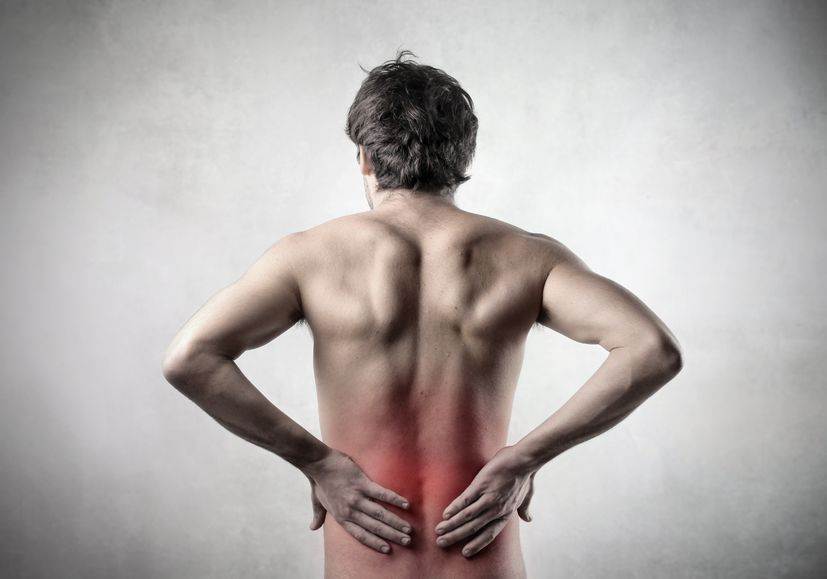
Discover the Best Sciatica Exercises for Pain Relief and Recovery
Persistent sciatica pain can transform daily activities into daunting tasks, leaving you searching for relief. If you’re on the hunt for effective strategies to alleviate sciatica and bolster your rehabilitation, welcome to your comprehensive guide. Here, we delve into not only the treatment options but also spotlight sciatica exercises that are crucial for pain relief and recovery. These exercises, when integrated with the professional care from your chiropractor or physiotherapist, are designed to reduce sciatica symptoms significantly.
Why Focus on Sciatica Exercises?
Exercises specifically tailored for sciatica play a pivotal role in managing and reducing pain. They are essential for strengthening the muscles supporting your spine, improving flexibility, and promoting healthy circulation to the affected nerve regions. This guide is your go-to resource for understanding how targeted exercises can complement medical treatments and accelerate your journey to relief and rehabilitation.
Understanding Sciatica: Sciatica Exercises
Sciatica is often described as a painful sensation that originates in the lower back or buttock, extending down through the thigh and leg, and occasionally reaching the foot. This discomfort results from the compression or irritation of the sciatic nerve. However, the root cause of this pinching can vary, necessitating precise diagnosis and tailored treatment plans.
The Complexity of Sciatica Causes: Sciatica Exercises
Identifying the exact source of sciatica is crucial, as nerve compression can occur at multiple points along its path. Misdiagnosis or oversimplification of your condition as merely “sciatica” without further investigation can lead to ineffective treatment strategies. It’s essential to understand whether the pain stems from issues like disc herniation, degenerative disc disease, or another underlying cause to ensure the appropriate therapeutic approach is employed.
See Also: Best Toronto Chiropractor: How To Find The Best Chiropractor In Your City
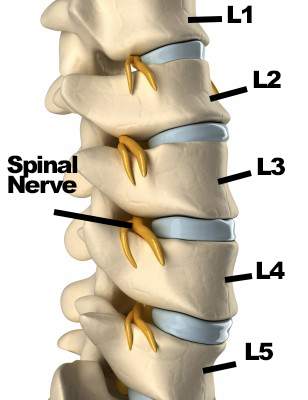
L4 and L5: Sciatica Exercises
So how do I know where my pinched nerve is? Two nerves come out between the last two vertebrae in your body. Your nerve is very commonly pinched here.
Your lower back vertebrae are called lumbar vertebrae. There are 5 vertebrae in the lower back. Taking the “L” for the lumbar spine, they are named L1, L2, L3, L4, and L5. The last two vertebrae in your lower back are L4 and L5.
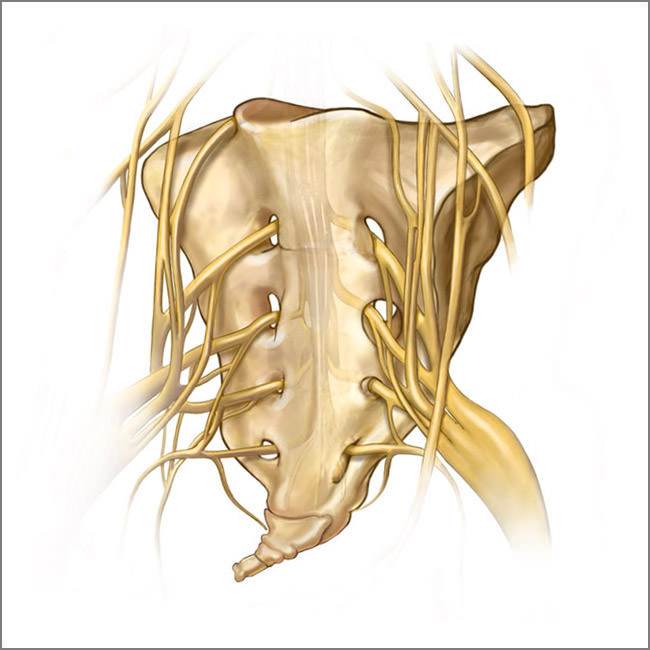
Ion medical designs http://www.ionmedicaldesigns.com/ion_site/two_dimensional_artwork.html
Just below L5 is one of your pelvic bones. It’s called the sacrum. The sacrum has holes with yellow-coloured nerves coming out.
S1, S2, S3: Sciatica Exercises
The nerves are called S1, S2 and S3. “S” is for sacrum. These nerves are rarely pinched.
Your sciatic nerve is formed when the nerves from L4 L5 and L5 S1 join together with the S1, S2 and S3 nerves in your buttock.
So, most of you will have your nerve pinched in one of three spots.
- In the buttock the Sciatic Nerve starts, in other words where the S1, S2, and S3 nerves join the two other nerves that come out between L4, L5 and L5 S1.
- Between L4 and L5 vertebrae
- Between L5 and S1 vertebrae
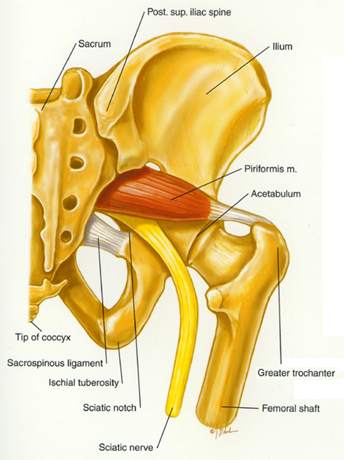
Now you know where the nerve can be pinched but it doesn’t answer why one of the nerves is pinched causing your sciatica
The Usual Suspects (Causes) of Sciatica
Most people’s sciatica is from:
- Herniated Disc at L45 or Herniated Disc at L5S1 (some osteoarthritis = “wear and tear” is involved)
- Degenerative Disc Disease (Osteoarthritis of the Disc=”Wear and Tear” of the Disc)
- Stenosis (Basically advanced osteoarthritis)
- Spondylolisthesis (A fracture of the vertebra or Osteoarthritis with the vertebra moving forward)
- Piriformis Syndrome
These are the diagnoses that your doctor or chiropractor should be telling you about not sciatica.
Remember sciatica only says that you have a pinched sciatic nerve causing pain in your buttock and leg, sciatica doesn’t tell you the cause of your pain. Without determining the cause you will get hit-or-miss treatments from your chiropractor or physiotherapist as they can’t give you specific treatment.
See Also: MRI CT scans X-rays, What’s Best For My Pain
The key exam that you need to determine what the heck is causing your pain is a neurological examination. You have probably seen it on TV before.
- Reflex tests with a reflex hammer on your knee and the back of your ankle
- Muscle Strength Testing: Resisted muscle testing of your foot. You try and push up/down while the chiropractor holds your foot. An alternative is heel walking and walking on your toes.
- Light Touch and Sharp Dull Testing: A light touch directly on the unclothed legs and feet to determine if you are unequal in your sensitivity to light touch and sharp/dull testing. A light touch is often enough as a screening.
Also, remember that the diagnosis should pretty much be determined in the office and X-rays, MRI, and CT scans done only if there are signs of something else or the diagnosis is kind of fuzzy.
See Also: Herniated Disc Part 2: The Best Exercises For Your Herniated Disc
Herniated Disc: Sciatica Exercises
You herniate a disc from the everyday habits that you have. The everyday habits of slouching and bending with a rounded low back, build up to weaken and damage the disc to the point it is ready to break open and herniate.
The problem is there is no pain. You don’t feel sciatica until the disc has herniated as there are no nerves inside the disc. So you continue your habits and think you don’t have a bad back until one day you lift your daughter off the floor.
The only problem is you had a bad back with no symptoms for a very long time. This is just like a car with a little bit of rust showing but if you take the car apart you see a lot more rust.
Degenerative Disc Disease – Osteoarthritis of the Disc
Degenerative Disc Disease is a continuation of the breakdown of the disc that was started by bad lifting and slouching habits.
The disc becomes smaller, and brittle like an old elastic band that is decaying, leading to the disc becoming smaller in height. The smaller disc makes the space between the vertebrae smaller. Thus, your nerve doesn’t have much room, so your nerve gets pinched between L4 and L5 or L5 and S1.
Stenosis- Most commonly from continuation of Osteoarthritis
Stenosis is a “narrowing”. There are two types of stenosis
- Lateral Stenosis
- Spinal Stenosis
1. Lateral Stenosis is the narrowing of the hole which the nerves from the spinal cord come from. Does this sound familiar? It’s degenerative disc disease + the bone degenerating forming spurs that narrow the hole for the nerve. A smaller hole for your nerve eventually means a pinched nerve.
2. Spinal Stenosis is the narrowing of the canal where the spinal cord sits. This is essentially pinching of the spinal cord usually in the lower back.
Spondylolisthesis (Vertebebra moving forward)
Spondylolisthesis is usually the moving forward of the vertebra (sometimes backwards). When the vertebra moves forward the spinal cord and nerves are pulled putting tension on your nerve. Nerves under tension get irritated and so turn into sciatica. This can happen from a fracture to the vertebrae or osteoarthritis.
Piriformis Syndrome
Most people’s sciatic nerve usually goes over or under the piriformis muscle. In some cases, possibly yours, the sciatic nerve goes right through the piriformis muscle. When the muscle tightens up it squeezes on the sciatic nerve causing sciatica.
Walking like a “man” is another reason for sciatica. That’s right, when you walk bow-legged with your feet turned can give you trouble later.
Chances are, if you are reading this you already have a problem with sciatica. When you turn your feet out this makes the piriformis muscles work harder.
The harder your piriformis works the more likely the nerve will be pinched causing sciatica.
The 4 Best Exercises For Sciatica
While treatments are different for sciatica depending on the cause you can still help your chiropractor or physiotherapist by doing your home exercises.
1. Flossing: first introduced by Michael Shacklock
Flossing is good for your teeth but a different kind of flossing is good for your spine and spinal hygiene.
First, determine if you can floss safely:
- Sit on a chair or relatively hard surface. Please don’t sit on the couch, it is too soft and will aggravate your lower back.
- Raise your painful leg to the point of pain and keep it there.
- Bend your neck forward till your pain is aggravated from above
- Lower the leg till the pain decreases.
If the pain decreases you are safe to do flossing.
Warning: This exercise can cause acute sciatica but chances are minimized by doing the screening exercise. Don’t floss until you have been out of bed for at least 2 hours. Now The Flossing:
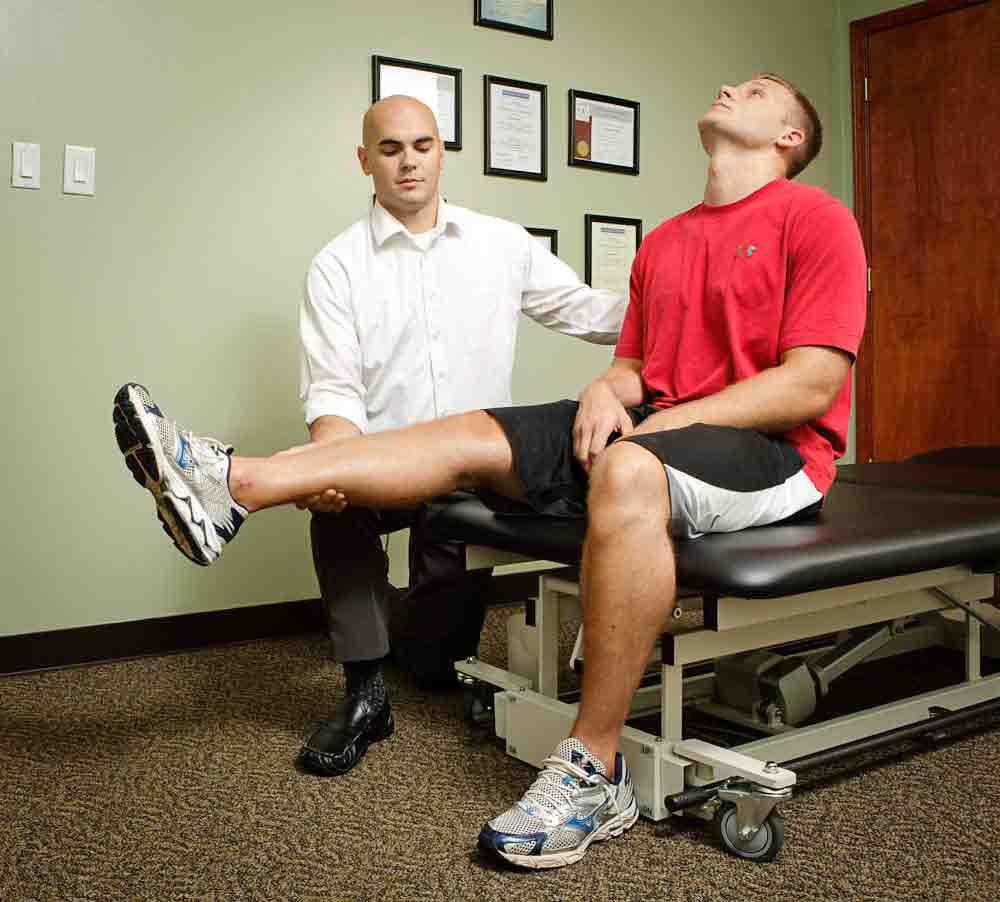
- Sit down in a chair with your legs swinging freely
- Bend your neck forward for 5 seconds (if this doesn’t cause sciatica you can do the next step)
- Bend your neck backwards as far as possible and straighten the knee (5 seconds)
- Repeat 3 sets of 10X on each leg. You can do this for up to 5/day.
2. Piriformis Stretch A) Sitting and B) Lying Face-Up
A: Sitting:
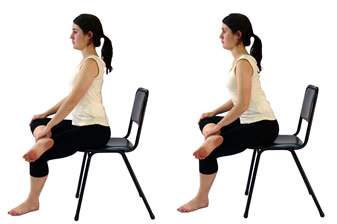
- Sit in a chair and cross the bad leg over the good
- Keep the arch in your back and move your chest forward
- Repeat 3 sets 30 secs. This can be done several times a day
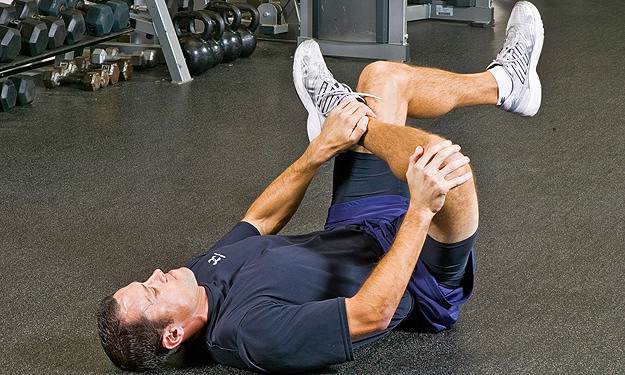
B: Lying Face-up: This exercise might be easier for some of you.
- Lying Face-up both knees bent. Put the bad leg over the good.
- Bring the good leg up to support the bad leg.
- Push the bad leg outward.
3. Ball Exercises: Piriformis, Gluteus Maximus, Gluteus Medius
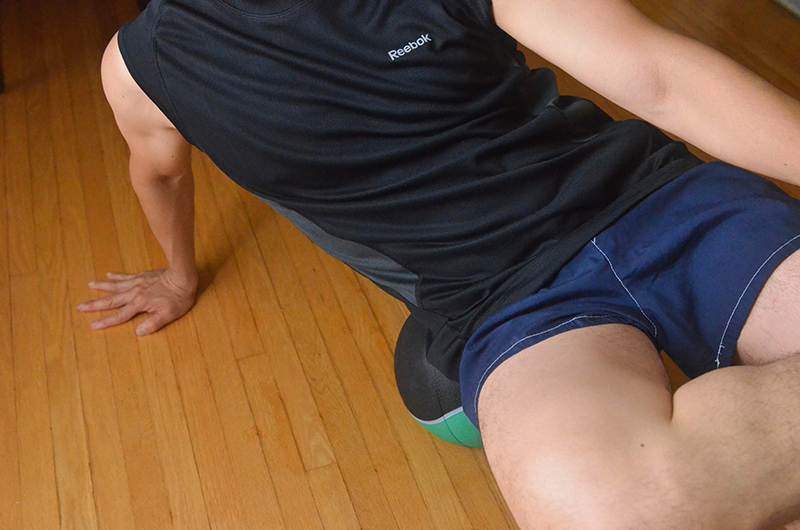
Piriformis
- Cross your bad side leg over the other knee
- Get a tennis ball, basketball or a medicine ball and sit on it with your buttock.
- To treat the piriformis go lean at about a 45-degree angle.
- Stop at each tender point and hold until each one is ironed out or feels less tender.
Gluteus Maximus
- Same as the piriformis except that you don’t need to cross the bad over the good.
Gluteus Medius
- Same as Gluteus Maximus except that you now lean at almost a 90-degree angle -You are almost on your side with a focus on the side area just below the belt or hip bone
4. Cobra
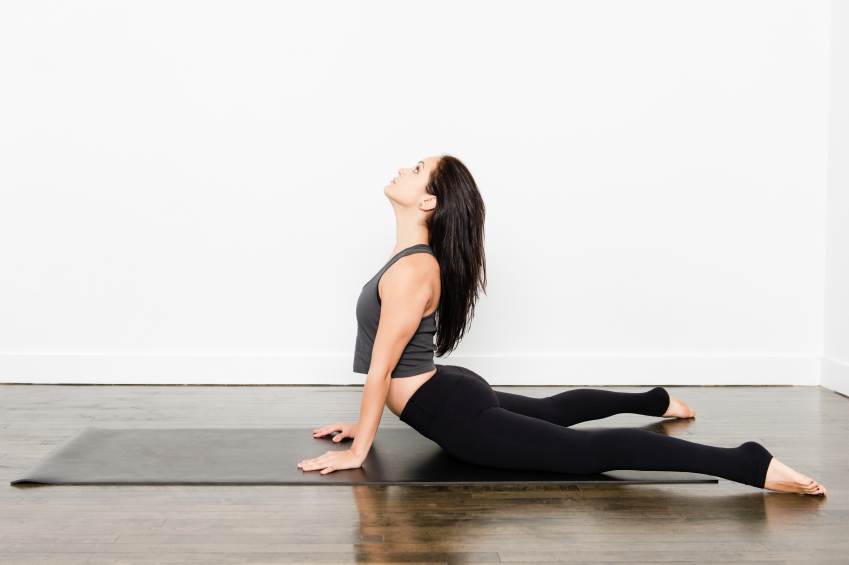
- Lie down face down with your hands underneath your shoulders.
- Push up from as high as you can until your lower back stops you or your elbows are straight.
- The pelvis should still be on the floor and the lower back muscles relaxed.
- Do these exercises hold each time for 1-2 seconds 6-8 times per set? This exercise can be repeated every two hours throughout the day.
If your pain is from a disc herniation you can combine the disc herniations part 2 exercises with these exercises. If your sciatica is from a different cause I will write about all the conditions that cause sciatica over time.
Write in the comments to tell us how you are doing with your sciatica. Also, let us know your vote for the best Toronto Chiropractor below. Connect with me on LinkedIn.


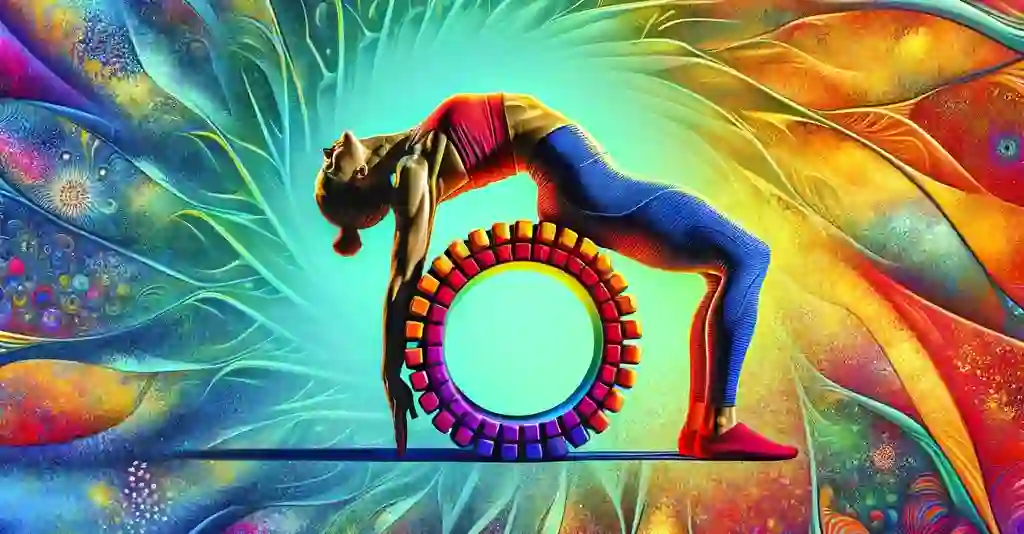
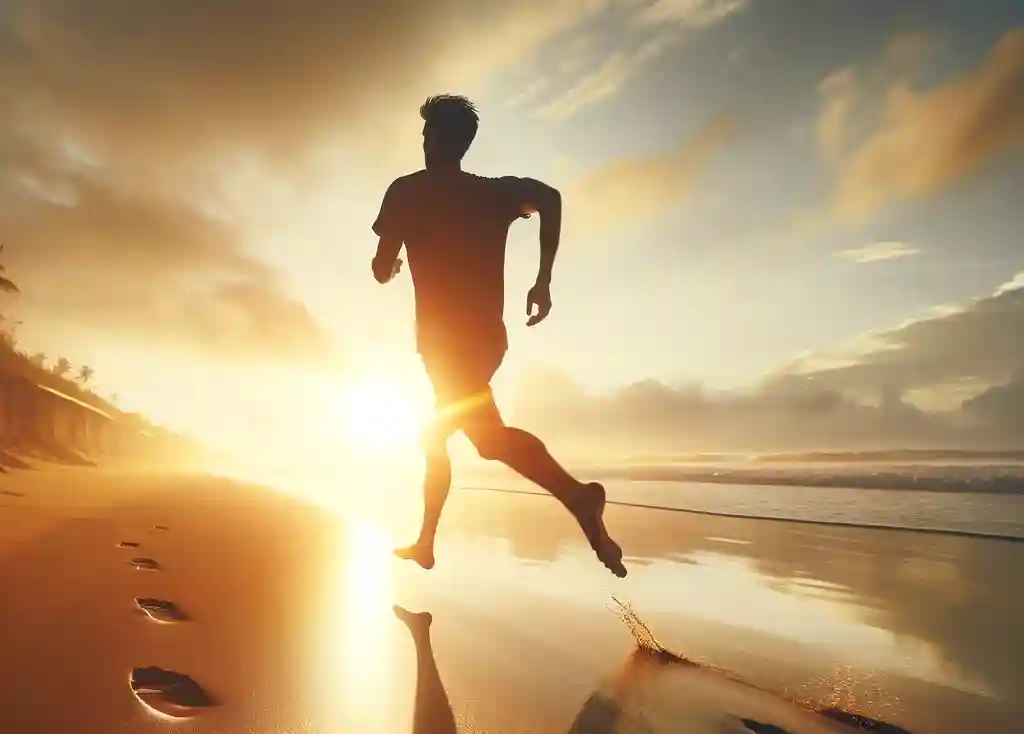
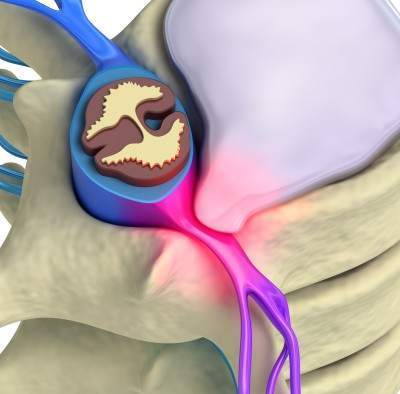
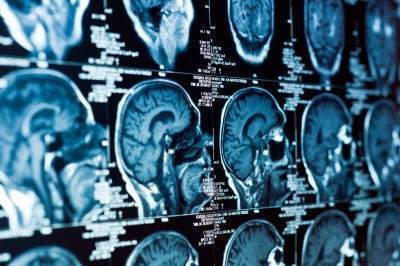
hi..I’ve a problem defect in L5-S1. so feel lot of pain duri
ng after sleeping, if more time to sit down and after starting it can’t be straight easily even that time happened so painfully. sometimes if I lift the wait then after a few time I feel more pain then before occur.
I’ve already visited orthopaedic doctors he said you have defective defects up to in borntimes and he also said that you can’t be able to any type of lift weight and can’t be do any activity like dance, etc so please help me doctor. …
Author
Thanks for your question Mithil. Not sure what “defective defects” are but I will assume that you mean you were born with some problem which is called a congenital defect. Most times the congenital defect is a fusion or partial fusion of the L5-S1 joints. This can lead to degeneration or osteoarthritis of the the disc at that level or right above. This will eventually cause a disc herniation.
I am making a lot of assumptions here so you have to tell me if I am correct or not by looking up “congenital defect” and “fusion”.
Then try these exercises. https://www.bodiempowerment.com/herniated-disc-part-2-the-best-exercises-for-your-herniated-disc/
If the exercises give you increased pain or increase symptoms further down the leg than you should stop.
Hope that helps your possible disc problem
Back disc l4 l5 compressed moderately to l5 nerve root . And l5 s1 disc mildly intending thecal sac s1 nerve root. I want to know can I cure completely with physiotherapy ? And once cured can this pain re occur? Waiting for ur response !
Author
Thanks for your question Div. You are talking to chiropractor so I will speak for chiropractors. Yes chiropractors deal with this problem all the time. Disc herniations are such a common day occurrence and I see people everyday with disc herniations that people want fixed. Yes most back pain is recurrent and episodic. Those that only read research will tell you that most back pain goes away after 6 weeks and doesn’t come back. There is plenty of evidence to back it. Also the reality is if you talk to 10 people that have had back pain over 50 they would had numerous episodes over the years.
So your answer is yes your pain is likely to reoccur.
Hope that help your sciatica.
Dr Ken please reply.
My MRI reports
Mild degree of disc bulge at L4-L5 level causing mild compression over bilateral exiting nerve roots.
I have this problem for six monthes. please tell me some exercise.
Author
Thanks Muhammad for your question. Try these exercises. https://www.bodiempowerment.com/herniated-disc-part-2-the-best-exercises-for-your-herniated-disc/
If the exercises give you increased pain or increase symptoms further down the leg than you should stop.
Hope that helps your mild disc bulge.
Thanks for the clarification and I have studied the other two articles you cited. Once again, thank you for such comprehensive and detailed information. I am heartily recommending these to my old buddies who are also looking for good information. My doctor of many years is also reviewing your sites with an eye toward directing patients who are seeking assistance for back ailments.
Author
Thanks for your question Tom. I appreciate the recommendation to your buddies. I also appreciate you showing your doctors.
Hope the exercises helps your sciatica.
Some clarification, please. In the warning statement accompanying flossing it is stated: “Don’t floss 2 hours after getting up from bed.” Does this mean not to floss if you have been up for two hours or more? I am a 72 year old male. My MRI (2009) of lower back states: “small left paracentral disc herniation identified of the L2-L3 level, with mild narrowing of the left lateral recess”. I have been looking for a set of exercises to offer some relief for the back/hip pain that I periodically experience. Wonderful site with much good information. Thank you.
Author
Thanks for your question Tom. “Don’t floss 2 hours after getting up from bed.” should read Don’t floss until you have been out of bed for at least 2 hours. This has now been changed. Hope that clarifies things.
Since you have a paracentral disc herniation here are two more articles that may interest you.
https://www.bodiempowerment.com/disc-herniation-part-1/
https://www.bodiempowerment.com/herniated-disc-part-2-the-best-exercises-for-your-herniated-disc/
Hope that helps your disc herniation.
I have Degenerative diseases which I also mean the L5L4.Is there another alternative way to live without doing a fusion to my lower back.I wanted to try out for the police department but now I feel limited.Are there exercise that can strength my lower back& live pain free without surgery?
Author
Thanks for your question Karima. Try these exercises for degenerative disc disease. https://www.bodiempowerment.com/part-2-degenerative-disc-disease-exercises-help-lower-back-pain-spondylosis/
Hope that helps your L4L5 degeneration.
My Mri report says I have protrusion on L4-5. It started as pain in both legs, buttocks and unable to sit and stand too long. I have gone for physio and improve slightly. Now I have low back pain also and this is my fourth month. I have been following your exercises and noticed a slight improvement. My right leg and buttock has pain and numbness every now and then , do I stop exercise or continue ? I am 60 years old and maybe the recovery is slow. My low back pain seems to have lessen after doing your exercise. I can now walk about 4000 steps a day
Author
Thanks for your question Lily. Try these exercises https://www.bodiempowerment.com/herniated-disc-part-2-the-best-exercises-for-your-herniated-disc/.
If the exercises give you more pain or any symptoms further down any leg than the exercises should be stopped.
Hope that helps your disc protrusion.
Thank you . When doing these exercises I don’t have pain but the pain or rather aches come after the exercises. Do I continue or wait till the aches disappear and then continue?
Author
Thanks for your question Lily. When you get increase pain that is a yellow flag. It means be cautious. If the pain continues for more than a minute than you should stop the exercises.
You might also try these exercsies https://www.bodiempowerment.com/herniated-disc-part-2-the-best-exercises-for-your-herniated-disc/
If the exercises give you increased aches, pains, numbness or any other symptoms further down the leg you should stop.
Hope that helps.
Hello, I have been reading your posts and it has me wondering if my condition might benefit from your advice. Here is what I am dealing with. I appreciate any input on this condition.
Findings: Stable appearance of anterior (C4-C6 ACDF) and
posterior (C5/C6) cervical spine fusion hardware. Patient is
status post posterior decompression at C3-C6. No periprosthetic
fractures or lucencies are noted. Mild anterolisthesis of C2 with
respect to C3 is noted, stable from prior. No significant change
is appreciated with flexion, however there is slight reduction
with extension (approximately 2 mm change). Mild anterolisthesis
is also noted at C7-T1, with no change on flexion but reduces on
extension (approximately 3-4 mm change). Severe disc space
narrowing is noted at C3-C4 and C6-C7. Multilevel mild lumbar
endplate proliferation is noted.
Impression:
1. No evidence of hardware complication. 2. Mild
anterolisthesis of C2-C3, stable from prior, with 2 mm
movement/instability on extension. 3. Mild anterolisthesis at
C7-T1, with 3-4 mm movement/instability on extension. 4. Severe
disc height loss and degenerative disease at C3-C4 and C6-C7.
On the neutral view there is approximately 5 mm of retrolisthesis of
L2 on L3. With extension this measures 6 mm and with flexion measures 8 mm. No
motion at the other levels.
I now have sciatica and can’t hardly walk when I first stand up from a sitting position. I have been getting steroid shots which give me approx. 2 mos of relief. Is there any exercise I could do that would help?
Thank you,
Lyn
Author
Thanks for your question Lynn. First, it looks like you have you wrote a lot about the neck with a part of your low back report. You have must have had severe accident that made your neck and lower back unstable resulting in fusion surgery in your neck but not the lower back. The lower back is now very unstable at L2L3.
You should try these exercises https://www.bodiempowerment.com/part-2-degenerative-disc-disease-exercises-help-lower-back-pain-spondylosis/
These are stability exercises.
Hope that helps your lumbar spinal instability.
Dr. Ken Nakamura,
Firstly many thanks for the useful blog. I would like to take oppertunity to share medical problem I’m suffering since 2006. My age is 39 years and suffering lower back pain since 2006. The history as below in cronological order –
1. First attack in 2006. Suddenly one fine morning I found myself unable to wake up from bed. Undergone physiotherapy for 2 weeks and normal excercise helped me.
2. Again on 2008. Medication and physiotherapy helped little but can’t get rid of pain completely.
3. 3rd attack in 2010 and 4th in Aug-2014. In between I’d gone thru several physio seatings and do regular excercise (not the one you recommended above).
4. Recently started sciatica pain. Even having medicin (paracetamol 1g + Mecobalamin capsule), physiotherapy and excercise no improvement observed after 3 weeks.
5. My consultant suggested to go for steriod now.
Now I started the above excercise recommended by you and have seen little improvement. But pain is still unbearable. I’ve few questions for your kind response –
1. Is sciatica pain increase in winter?
2. What else I can do to reduce the pain other than excercise?
3. If I go for steriod what is the side effect? Will it safe and don’t cause any future medical issue?
Author
Thanks for your question Sumanta. Generally speaking osteoarthritis can increase pain in the winter time but if your problem is a disc it will not make a difference.
2. First I would try these exercises. https://www.bodiempowerment.com/herniated-disc-part-2-the-best-exercises-for-your-herniated-disc/
Other things that decrease pain include steroid injections and surgery.
3. Steroid injections can used a maximum of three times. If you get an inexperienced person they can permanently damage your spine or if it’s an epidural cut the nerves with the syringe. It is generally safe and certainly much safer than surgery. Everything has a risk. Taking medication has risks, Crossing the street has risks especially in India if you are from there. You have to weigh the benefit with the risks than determine if it’s worth the risk. I haven’t looked it up but you probably have more chance of getting seriously injured crossing the street in Mumbai than getting a steroid injection. Do your homework and ask the patients that this doctor previously treated if they will give you the information.
Hope that helps your sciatica.
Thanks Doctor. Here’s MRI Report –
The L5-S1 disc is desiccated. Mild to moderate diffuse posterior bulging of L4-5 disc is noted compressing the ventral thecal sac and bilateral neuroforamina. The L5-S1 disc shows posterocentral focal bulging with left sided predilection compression the ventral thecal sac and left L5-S1 neuroforamen.
L1-2= 20 mm; L2-3= 21mm; L3-4= 20 mm; L4-5=17mm; L5-S1=13mm
Few more questions on steriod (I heard below in general discussion) –
1. Will Steroid increase blood sugar? (as of now I dont have blood sugar)
2. Once applied, will pain killer work in future as steriod is extrem form of pain killer?
3. Are prolong seating (my job demand that) and car driving triggering factors?
4. Will heat therapy good for sciatica pain?
Thanks in advance.
Author
Thanks for your question Sumanta.
1. Steroids will usually increase blood sugar.
2. Steroids are an anti-flammatory and immmunosupressive. So painkillers will work fine afterwards
3. Sitting and driving which is also sitting increases pressure on the disc and causes bulging of the disc and so aggravates symptoms.
4. Heat will mask the pain but will do very little to help your pain.
Hope that helps your disc herniation.
Thanks Doctor. I’ll come back after 1 week of extensive excercise. Let me give a last try before I go for steriod.
Nevertheless, I would like to show my gratitude for your kind advice and direction. My best regards.
Author
Thanks for your question Sumanta. First you can use these exercises https://www.bodiempowerment.com/herniated-disc-part-2-the-best-exercises-for-your-herniated-disc/
I am not sure what exercises you are going to do. If you do the wrong ones you can harm yourself.
Also it takes a lot longer than one week to heal from these disc herniations.
Hope that helps
Sir i am suffewring from slip disc at L4-L5 and L5-S1 from 3 year and still it is .I want to know how to get rid from this.Please sir give me some usefull tips.
Thanks
Author
Thanks for your question Shantanu. Try these exercises. https://www.bodiempowerment.com/herniated-disc-part-2-the-best-exercises-for-your-herniated-disc/
If the exercises increase the pain or make the pain go further down into the buttock or leg than you should stop.
Hope that helps your slipped disc.
Hi Dr. Ken Nakamura
At the age of 16 I had a fall and severely bulged my L4-L5 disc and weakened the L5-S1 disc. I began experiencing radiating pain and numbness down my right leg. At the time my doctor determined that surgery was the way to go. So we went ahead with surgery. My doctor informed me then that because my L5-S1 disc was weakened I would have issues again later on down the road. So here we are 13 years later with the same issue only 10x worse then the first time. I currently have 3 bulges L2-L3, L3-L4 and a severe bulge at L5-S1.Walking is the most I can do and even that is with pain.
I’m currently doing spinal decompression on the DRX 9000 machine. I’ve already had 20 sessions. It definitely helped in the first 2 weeks by decreasing some of the sharp unbearable pain but I’m still no where near pain free. I take pain killers almost daily just to get through my day. My question to you is, what else should I try? What do you recommend? I realize surgery is probably where I’ll end up, but if at all possible I would rather avoid going this route.
Thanks in advance!
Author
Thanks for your comment Joanna. You have quite a severe problem. You can try these exercises. Especially lying prone when first getting out of bed. You can also try the sphinx exercise in the link. https://www.bodiempowerment.com/herniated-disc-part-2-the-best-exercises-for-your-herniated-disc/
Likely any more than that and you will aggravate the problem. I would seek out the opinion of the most respected chiropractor in your area.
Hope that helps your herniated disc.
Hello, I was told that Pilates exercise can also be helpful for getting rid of back pain, is it correct?
Author
Thanks for your question MaryPLT. Pilates exercises are very helpful while some are harmful for certain types of back pain. If you have severe or moderate back pain I would not recommend it as you can harm your lower back. For mild lower back pain you can do the exercise and if you temporarily aggravated your pain you can learn to avoid those exercises that are harmful. With moderate to severe pain you can set yourself back for days or worse.
So I recommend Pilates for people with mild low back pain to strengthen core and also to prevent low back pain.
Hope that helps your low back pain.
aslam u allikum doctor
im rizwan im 19 years old i am suffering from L4-L5 disease its been more than 2 years .i just want to ask the pros and cons of operation for these disease? i want to be a sports man .what would be better go with exercise or operation?
Author
Thanks for the question Rizwan. First you always do exercises first then injections then surgery. You don’t decide between the two. Here are two articles that tell you why you shouldn’t pick between surgery and exercises but almost always do exercises first. Remember surgery is permanent, has a 50% failure rate causes scar tissue and exercises help the vast majority of the time.
https://www.bodiempowerment.com/beware-surgery-low-back-pain/
https://www.bodiempowerment.com/disc-herniation-surgeries-half-fail/
Here are the exercises to try. https://www.bodiempowerment.com/part-2-degenerative-disc-disease-exercises-help-lower-back-pain-spondylosis/
Hope that helps your L4-L5 DDD (Degenerative disc disease)
Hello Dr.Ken
I have been having back pain for the past year or so especially when standing or sitting for over 5 mins. My MRI reads:L3-L4 disc dehydration with diffuse disc bulge indenting on thecal sac causing mild bilateral neural foraminae narrowing.
I usually walk a bit faster and play badminton and tennis. I had a meniscus tear on my left knee and underwent arthroscopic surgery in 2013.
Could you please advice what exercises I can do to overcome the pain?
BR/ Karthik
Author
Thanks for your question Karthik. You should try these exercises. https://www.bodiempowerment.com/herniated-disc-part-2-the-best-exercises-for-your-herniated-disc/
If the exercises give you increased pain or pain/ numbness or tingling further down the leg or buttock then you should stop the exericses.
Hope that helps your disc bulge.
I have an extra vertebrae in my lower back. Could this be the reason for sciatica?
Author
Thanks for your question Jessica. Yes an extra vertebra will changes the motion of the vertebrae and result in less movement in each of the above vertebrae. Over time this results in earlier DDD (degnerative disc disease) and disc bulges. Having said that most of us do have disc bulges. If you look at 100 people on MRI 30% will have a disc herniation or bulge. These are all people without pain. So don’t get too hung up about the extra vertebrae and resign yourself to pain.
Try the exercises here first https://www.bodiempowerment.com/herniated-disc-part-2-the-best-exercises-for-your-herniated-disc/.
Don’t do the exercises if the exercises give you more pain or makes the pain go further down the leg.
Hope that helps your sciatica.
Disc protrusion at l5 s1 with its inferior migration compressing upon the left sided neurel tissue……..
suffering from february 2014… My Question is…… what i normal recovery time of disc protrusion if i’ll not go for surgery,,,, how long its goes normaly? can a disc go back to its original position and release the compression on spinal? without any surgery.. how long i will have to bear the pain with precautions?
can it be recover with the passage of time?
Author
Thanks for our question ALI. First everybody heals at different rates it depends if you smoke or have other health problems like diabetes. In your case it sound like you have one of the most serious kinds of disc herniations. If you have inferior migration it is usually more than a disc protrusion. Your radiologist likely is mixing terminologies.
You should try these exercises. https://www.bodiempowerment.com/herniated-disc-part-2-the-best-exercises-for-your-herniated-disc/
Also read this to prevent your self from aggravating yourself.https://www.bodiempowerment.com/disc-herniation-part-1/
Hope that helps your possible disc sequestration (my point of view)
i am bearing a lot of pain in my left leg due to this l5 s1 disc protrusion (inferior migration) i had visited to neurosurgeon… and he refer me Epidural block injection… will it work according to your point of view?? i didnt get the high relief in last 10 months with medicine and excercises.. life is going worse…. and it make me down mently also…. Kindly suggest… Sorry for spelling mistake.
Author
Thanks for your question Ali. It depends what is in the epidural injection. If it is just a pain killer it will simply block your pain and you will make yourself worse without knowing it. If it has cortisone as well as pain killers it might be helpful if you have chronic inflammation. This will give exercises a chance to work with decreased inflammation, and eventually some healing of the tissues.
This is by no means guaranteed but well worth a shot. So the recommendation is to get the shot then try the exercises with a professional or you can try exercises here: https://www.bodiempowerment.com/herniated-disc-part-2-the-best-exercises-for-your-herniated-disc/
If the exercises make the pain or symptoms more intense or make the symptoms further down the leg or buttock than you should stop the exercises for the time being.
Hope that helps your disc protrusion.
I am trying these mentioned exercises …. after 1 month i feel that not is hurting as well as nor its working, but from the one corner of my mind and heart i feel that its working little bit, but not as i was thinking…this excercise make my left side of back little swell….. should i continue these exercises? its not hurting my back and leg at all..
what you believe that who long ussually it take to heal? ussually… not in my case.. am asking general….
Author
Thanks for your question Ali. It could be a question of not doing the exercises correctly. I often show patients their exercises and get them to do it. They are doing it perfectly when they leave. The next time they come in, I ask them to show me the exercises. People often do the exercises in their own way. In other words they are doing it wrong. So when you compare me showing a patient and you trying to do the exercises from a picture and explanation their is a greater likelihood that you will do the exercises incorrectly.
Also you are assuming that the diagnosis that your doctor gave you are you diagnosed yourself is correct. If the diagnosis is incorrect than the exercises will not help as they are specific for sciatica related to disc herniations not bony stenosis or claudication.
Having said that you should also try these exercises.
https://www.bodiempowerment.com/herniated-disc-part-2-the-best-exercises-for-your-herniated-disc/
Keep in mind if the pain gets worse or their is increase in symptoms or further into the down into the buttock, thigh or leg you should stop.
Hope that helps.
So… u Suggest me to carry on? in better n real way……
Author
Thanks for your comment. You should get a second opinion from a person that can examine you.
Hope that helps your back pain.
It lower my leg pain…near to finish….. but back pain is still there after the 2 month excercise… is it working?
Author
Thanks for your question. If the exercises aren’t helping than you should consult someone that can examine you in person.
Hope that helps your sciatica.
Dear Sir,
While I am searching for a solution to my back pain, I found your website. I am having lower back pain near my buttocks region and I feeling a pain in my left leg just above my foot. I am having this problem for the last 3 years.
My MRI report is saying that, 1) Early dehydration of L4-L5 and L5-S1 discs, 2) Broad based left paracentral protrusion with posterior annular tear is seen causing compression of thecal sac with bilateral narrowing of lateral recesses, more so in left side with minimal (<1/3) neural foramina compromise at L4-L5 level, 3) Multi level mild facet joint arthropathy is seen with minimal facetal effusion.
Is there any solution for this? What kind of exercise can I do for this problem sir?
Thanks a lot.
Author
Thanks for your question Vigneysh. You should try these exercises to see if they will help. https://www.bodiempowerment.com/herniated-disc-part-2-the-best-exercises-for-your-herniated-disc/
Exercises don’t always help but they do help a lot of people. When doing the exercises if you get increasing pain afterwards that stays increased or the pain goes further down the leg than you shouldn’t do the exercises.
Hope that helps your disc paracentral protrusion.
Dear Dr.Ken, Thanks a lot for your suggestion. I will try those exercise to see whether I have any improvements or not. Is there any permanent way to cure this problem without surgery ? What are the precautions I have to take ?
i have had slip disc twice 2010 & 2014. This last one led to sciatica & was billed for surgery. what do i do?
Author
Thanks for your question YINKA. I think what you mean is that you are now scheduled for surgery after having slipped your disc twice. I would try exercises first, if I were in your position. https://www.bodiempowerment.com/herniated-disc-part-2-the-best-exercises-for-your-herniated-disc/
If the exercises increase your pain, tingling, or causes numbness to change to numbness or causes the symptoms to go further down the leg than the exercises are not for you.
Hope that helps your slipped disc.
Dear Sir, My MRI report says Right para central protrusion of L4-5 is indenting the traversing right L5 nerve root. What do you suggest sir
Author
Thanks for your question Sarveshwar. Why don’t you try these exercises. https://www.bodiempowerment.com/herniated-disc-part-2-the-best-exercises-for-your-herniated-disc/
If the exercises give you pain further down the leg or buttock or increase the intensity of pain /nubmness or tingling than you should stop the exericses.
Hope that helps your L45 paracentral protrusion.
i am suffering from sciatica because of my disc bulging at l4l5 . what should i do for better excercise to remove my sciatica problem ? and how can i bring my disc incorrect position ?
Author
Thanks for your question Dipen. Why don’t you try these exercises. https://www.bodiempowerment.com/herniated-disc-part-2-the-best-exercises-for-your-herniated-disc/
If the exercises makes the leg pain more painful, or goes further down the leg or goes from tingling to numbness the exercises are for you.
Hope that helps your lower back bulging disc.